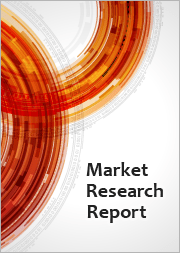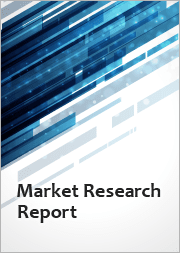
|
시장보고서
상품코드
1619081
세계의 펩티드 치료제 시장 : 규모, 점유율, 성장 분석, 유형별, 제조업체별, 합성 기술별, 투여 경로별, 용도별, 지역별 업계 예측(2024-2031년)Peptide Therapeutics Market Size, Share, Growth Analysis, By Type (Generic, Innovative), By Type of Manufacturers (In-house, Outsourced), By Synthesis Technology, By Route of Administration, By Application, By Region - Industry Forecast 2024-2031 |
||||||
펩티드 치료제 시장 규모는 2022년에 406억 9,000만 달러로 평가되었고, 예측 기간(2024-2031년)의 CAGR은 5.94%로, 2023년 431억 1,000만 달러에서 2031년에는 684억 달러로 나타날 전망입니다.
펩티드 치료제 수요는 만성 질환의 유병률 증가와 창약에 대한 투자 증가에 의해 크게 성장할 전망입니다. 시장 전망은 더욱 확대될 것으로 보입니다. 위를 밀어 올 것으로 예상됩니다. 암 이환율 증가는 종양학에서 조사 펩티드 치료제의 사용을 촉진하는 반면, 바이오 의약품 연구에 대한 정부의 자금 지원은이 분야의 새로운 기회를 나타냅니다. 그러나 제한된 경구 생체이용률, 높은 제조 비용, 생물학적 제제와의 경쟁과 같은 과제는 장기적인 성장 가능성을 방해할 수 있습니다.
목차
소개
- 조사의 목적
- 조사 범위
- 정의
조사 방법
- 정보 조달
- 2차 데이터와 1차 데이터의 방법
- 시장 규모 예측
- 시장의 전제조건과 제한
주요 요약
- 세계 시장 전망
- 공급과 수요 동향 분석
- 부문별 기회 분석
시장 역학과 전망
- 시장 개요
- 시장 규모
- 시장 역학
- 성장 촉진요인과 기회
- 억제요인과 과제
- Porter's Five Forces 분석과 영향
- 경쟁 기업간 경쟁 관계
- 대체품의 위협
- 구매자의 협상력
- 신규 진입업자의 위협
- 공급기업의 협상력
주요 시장 인사이트
- 중요성공요인
- 경쟁도
- 주요 투자 기회
- 시장 생태계
- 시장의 매력 지수(2023년)
- PESTEL 분석
- 거시경제지표
- 밸류체인 분석
- 가격 분석
- 기술의 진보
- 규제 상황
- 사례 연구
- 고객 및 구매 기준 분석
펩티드 치료제 시장 규모 : 유형별 및 CAGR(2024-2031년)
- 시장 개요
- 제네릭
- 혁신적
펩티드 치료제 시장 규모 : 제조업체별 및 CAGR(2024-2031년)
- 시장 개요
- 사내
- 아웃소싱
펩티드 치료제 시장 규모 : 합성 기술 및 CAGR(2024-2031년)
- 시장 개요
- 고상 펩티드 합성(SPPS)
- 액상 펩티드 합성(LPPS)
- 하이브리드 기술
펩티드 치료제 시장 규모 : 투여 경로별 및 CAGR(2024-2031년)
- 시장 개요
- 비경구 투여
- 경구 투여
- 폐
- 점막
- 기타
펩티드 치료제 시장 규모 : 용도별 및 CAGR(2024-2031년)
- 시장 개요
- 암
- 대사 장애
- 심혈관 질환
- 호흡기 질환
- 위장 장애
- 감염증
- 통증
- 피부질환
- 신경질환
- 신장 질환
- 기타
펩티드 치료제 시장 규모 및 CAGR(2024-2031년)
- 북미
- 미국
- 캐나다
- 유럽
- 영국
- 독일
- 스페인
- 프랑스
- 이탈리아
- 기타 유럽
- 아시아태평양
- 중국
- 인도
- 일본
- 한국
- 기타 아시아태평양
- 라틴아메리카
- 브라질
- 기타 라틴아메리카
- 중동 및 아프리카
- GCC 국가
- 남아프리카
- 기타 중동 및 아프리카
경쟁 정보
- 상위 5개사 비교
- 주요 기업의 시장 포지셔닝(2023년)
- 주요 시장 기업이 채용한 전략
- 시장의 최근 동향
- 기업의 시장 점유율 분석(2023년)
- 주요 기업의 기업 프로파일
- 기업 개요
- 제품 포트폴리오 분석
- 부문별 점유율 분석
- 수익의 전년대비 비교(2021-2023년)
주요 기업 프로파일
- Eli Lilly and Company
- Amgen Inc.
- Pfizer Inc.
- Bristol-Myers Squibb Company
- Novo Nordisk A/S
- Takeda Pharmaceutical Company Limited
- AstraZeneca PLC
- Sanofi SA
- GlaxoSmithKline PLC
- Novartis AG
- Zealand Pharma A/S
- AmbioPharm Inc.
- Bachem Holding AG
- PolyPeptide Group
- Circle Pharma, Inc.
- PeptiDream Inc.
- Apitope Technology Ltd.
- Ever Neuro Pharma GmbH
- Teva Pharmaceuticals Industries Ltd.
- Arch Biopartners Inc.
결론과 권장사항
JHS 25.01.09Peptide Therapeutics Market size was valued at USD 40.69 billion in 2022 and is poised to grow from USD 43.11 billion in 2023 to USD 68.4 billion by 2031, growing at a CAGR of 5.94% in the forecast period (2024-2031).
The demand for peptide therapeutics is poised for significant growth driven by the escalating prevalence of chronic diseases and increased investment in drug discovery. Awareness of the low toxicity associated with these treatments among patients and healthcare professionals is likely to further enhance market prospects. Innovations in peptide synthesis are anticipated to boost sales, complemented by the rising adoption of targeted therapies known for their precision in addressing various medical conditions. The increasing incidence of cancer will catalyze the use of peptide therapeutics in oncology, while supportive government funding for biopharmaceutical research will unveil new opportunities in the sector. However, challenges such as limited oral bioavailability, high production costs, and competition from biologics may hinder long-term growth potential.
Top-down and bottom-up approaches were used to estimate and validate the size of the Peptide Therapeutics market and to estimate the size of various other dependent submarkets. The research methodology used to estimate the market size includes the following details: The key players in the market were identified through secondary research, and their market shares in the respective regions were determined through primary and secondary research. This entire procedure includes the study of the annual and financial reports of the top market players and extensive interviews for key insights from industry leaders such as CEOs, VPs, directors, and marketing executives. All percentage shares split, and breakdowns were determined using secondary sources and verified through Primary sources. All possible parameters that affect the markets covered in this research study have been accounted for, viewed in extensive detail, verified through primary research, and analyzed to get the final quantitative and qualitative data.
Peptide Therapeutics Market Segmental Analysis
Peptide Therapeutics Market is segmented by Type, Type of Manufacturers, Synthesis Technology, Route of Administration, Application and region. Based on Type, the market is segmented into Generic, Innovative. Based on Type of Manufacturers, the market is segmented into In-house, Outsourced. Based on Synthesis Technology, the market is segmented into Solid Phase Peptide Synthesis (SPPS), Liquid Phase Peptide Synthesis (LPPS), Hybrid Technology. Based on Route of Administration, the market is segmented into Parenteral, Oral, Pulmonary, Mucosal, Others. Based on Application, the market is segmented into Metabolic Disorders, Cardiovascular Disorders, Respiratory Disorders, Gastrointestinal Disorders, Infectious Diseases, Pain, Dermatological Disorders, Neurological Disorders, Renal Disorders, Others. Based on region, the market is segmented into North America, Europe, Asia Pacific, Latin America and Middle East & Africa.
Driver of the Peptide Therapeutics Market
The peptide therapeutics market is significantly driven by the increasing prevalence of chronic diseases, attributed to unhealthy lifestyle choices and habits that have become more common globally. As conditions such as diabetes and cancer continue to rise, there is an escalating demand for more effective and safer treatment options. Peptide therapeutics are particularly favored due to their low toxicity profiles, making them an appealing alternative for patients suffering from various chronic ailments. This growing recognition of peptide treatments as viable solutions underscores their importance in the evolving landscape of medical therapies, further propelling the market forward.
Restraints in the Peptide Therapeutics Market
The Peptide Therapeutics market faces significant restraints, particularly due to the limited oral bioavailability of peptides. When ingested orally, peptides are prone to degradation by digestive enzymes, which significantly restricts their effective administration in this manner. As a result, most peptide therapeutics are delivered through invasive methods like injections. However, many patients are reluctant to choose these invasive options, as they generally favor non-invasive treatment alternatives. This limitation on administration routes poses a challenge for the growth and acceptance of peptide therapeutics in the market, as it reduces patient adherence and overall treatment satisfaction.
Market Trends of the Peptide Therapeutics Market
The peptide therapeutics market is experiencing a significant trend towards the development of oral formulations, a sector currently underexploited compared to injectables. As consumer preference shifts towards non-invasive administration methods, companies that strategically invest in research to create orally bioavailable peptides stand poised to gain a competitive edge. The challenges of oral delivery, such as stability and absorption, are substantial, but the potential rewards are immense, including increased patient compliance and expanded market share. Investments in innovative drug delivery technologies and formulations could yield transformative products, propelling industry growth and establishing new standards in peptide therapeutics by 2025 and beyond.
Table of Contents
Introduction
- Objectives of the Study
- Scope of the Report
- Definitions
Research Methodology
- Information Procurement
- Secondary & Primary Data Methods
- Market Size Estimation
- Market Assumptions & Limitations
Executive Summary
- Global Market Outlook
- Supply & Demand Trend Analysis
- Segmental Opportunity Analysis
Market Dynamics & Outlook
- Market Overview
- Market Size
- Market Dynamics
- Driver & Opportunities
- Restraints & Challenges
- Porters Analysis & Impact
- Competitive rivalry
- Threat of substitute
- Bargaining power of buyers
- Threat of new entrants
- Bargaining power of suppliers
Key Market Insights
- Key Success Factors
- Degree of Competition
- Top Investment Pockets
- Market Ecosystem
- Market Attractiveness Index, 2023
- PESTEL Analysis
- Macro-Economic Indicators
- Value Chain Analysis
- Pricing Analysis
- Technological Advancement
- Regulatory Landscape
- Case Studies
- Customer & Buying Criteria Analysis
Global Peptide Therapeutics Market Size by Type & CAGR (2024-2031)
- Market Overview
- Generic
- Innovative
Global Peptide Therapeutics Market Size by Type of Manufacturers & CAGR (2024-2031)
- Market Overview
- In-house
- Outsourced
Global Peptide Therapeutics Market Size by Synthesis Technology & CAGR (2024-2031)
- Market Overview
- Solid Phase Peptide Synthesis (SPPS)
- Liquid Phase Peptide Synthesis (LPPS)
- Hybrid Technology
Global Peptide Therapeutics Market Size by Route of Administration & CAGR (2024-2031)
- Market Overview
- Parenteral Route
- Oral Route
- Pulmonary
- Mucosal
- Others
Global Peptide Therapeutics Market Size by Application & CAGR (2024-2031)
- Market Overview
- Cancer
- Metabolic Disorders
- Cardiovascular Disorders
- Respiratory Disorders
- Gastrointestinal Disorders
- Infectious Diseases
- Pain
- Dermatological Disorders
- Neurological Disorders
- Renal Disorders
- Others
Global Peptide Therapeutics Market Size & CAGR (2024-2031)
- North America, (Type, Type of Manufacturers, Synthesis Technology, Route of Administration, Application)
- US
- Canada
- Europe, (Type, Type of Manufacturers, Synthesis Technology, Route of Administration, Application)
- UK
- Germany
- Spain
- France
- Italy
- Rest of Europe
- Asia-Pacific, (Type, Type of Manufacturers, Synthesis Technology, Route of Administration, Application)
- China
- India
- Japan
- South Korea
- Rest of Asia Pacific
- Latin America, (Type, Type of Manufacturers, Synthesis Technology, Route of Administration, Application)
- Brazil
- Rest of Latin America
- Middle East & Africa, (Type, Type of Manufacturers, Synthesis Technology, Route of Administration, Application)
- GCC Countries
- South Africa
- Rest of Middle East & Africa
Competitive Intelligence
- Top 5 Player Comparison
- Market Positioning of Key Players, 2023
- Strategies Adopted by Key Market Players
- Recent Developments in the Market
- Company Market Share Analysis, 2023
- Company Profiles of All Key Players
- Company Details
- Product Portfolio Analysis
- Company's Segmental Share Analysis
- Revenue Y-O-Y Comparison (2021-2023)
Key Company Profiles
- Eli Lilly and Company
- Company Overview
- Business Segment Overview
- Financial Updates
- Key Developments
- Amgen Inc.
- Company Overview
- Business Segment Overview
- Financial Updates
- Key Developments
- Pfizer Inc.
- Company Overview
- Business Segment Overview
- Financial Updates
- Key Developments
- Bristol-Myers Squibb Company
- Company Overview
- Business Segment Overview
- Financial Updates
- Key Developments
- Novo Nordisk A/S
- Company Overview
- Business Segment Overview
- Financial Updates
- Key Developments
- Takeda Pharmaceutical Company Limited
- Company Overview
- Business Segment Overview
- Financial Updates
- Key Developments
- AstraZeneca PLC
- Company Overview
- Business Segment Overview
- Financial Updates
- Key Developments
- Sanofi SA
- Company Overview
- Business Segment Overview
- Financial Updates
- Key Developments
- GlaxoSmithKline PLC
- Company Overview
- Business Segment Overview
- Financial Updates
- Key Developments
- Novartis AG
- Company Overview
- Business Segment Overview
- Financial Updates
- Key Developments
- Zealand Pharma A/S
- Company Overview
- Business Segment Overview
- Financial Updates
- Key Developments
- AmbioPharm Inc.
- Company Overview
- Business Segment Overview
- Financial Updates
- Key Developments
- Bachem Holding AG
- Company Overview
- Business Segment Overview
- Financial Updates
- Key Developments
- PolyPeptide Group
- Company Overview
- Business Segment Overview
- Financial Updates
- Key Developments
- Circle Pharma, Inc.
- Company Overview
- Business Segment Overview
- Financial Updates
- Key Developments
- PeptiDream Inc.
- Company Overview
- Business Segment Overview
- Financial Updates
- Key Developments
- Apitope Technology Ltd.
- Company Overview
- Business Segment Overview
- Financial Updates
- Key Developments
- Ever Neuro Pharma GmbH
- Company Overview
- Business Segment Overview
- Financial Updates
- Key Developments
- Teva Pharmaceuticals Industries Ltd.
- Company Overview
- Business Segment Overview
- Financial Updates
- Key Developments
- Arch Biopartners Inc.
- Company Overview
- Business Segment Overview
- Financial Updates
- Key Developments



















